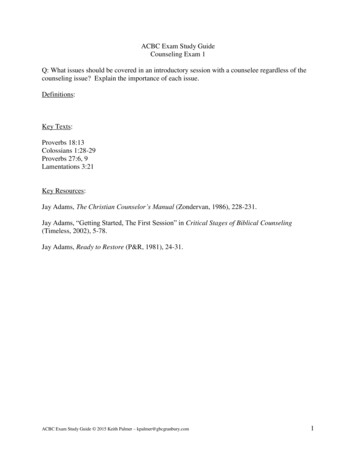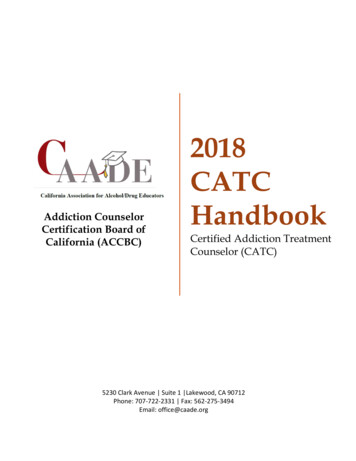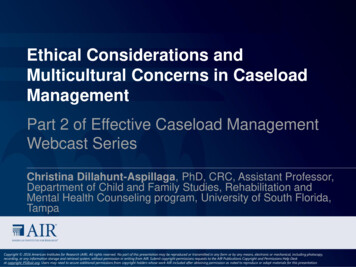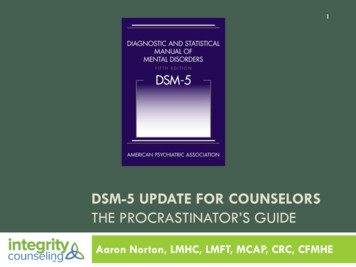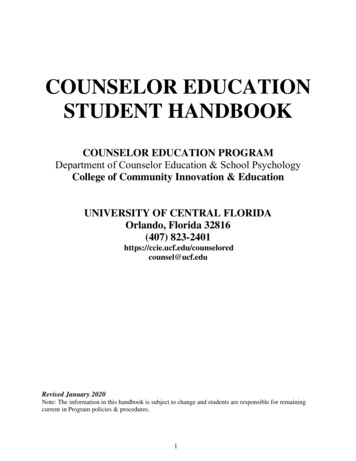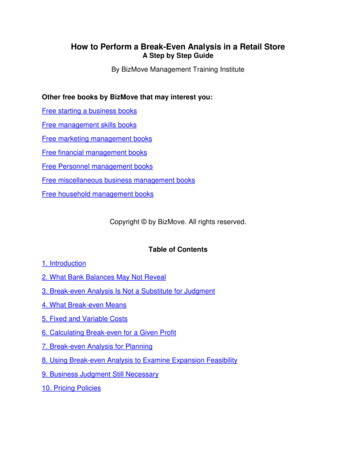
Transcription
A Counselor’s Guide toWORKINGWITHMENMatt Englar-CarlsonMarcheta P. EvansThelma DuffeyAMERICAN COUNSELINGASSOCIATION5999 Stevenson Avenue Alexandria, VA 22304www.counseling.org
A Counselor’s Guide toWORKINGWITHMENCopyright 2014 by the American Counseling Association. All rights reserved.Printed in the United States of America. Except as permitted under the UnitedStates Copyright Act of 1976, no part of this publication may be reproduced ordistributed in any form or by any means, or stored in a database or retrievalsystem, without the written permission of the publisher.10987654321American Counseling Association5999 Stevenson AvenueAlexandria, VA 22304Associate Publisher Carolyn C. BakerProduction Manager Bonny E. GastonCopy Editor Kimberly W. KinneEditorial Assistant Catherine A. BrumleyCover and text design by Bonny E. Gaston.Library of Congress Cataloging-in-Publication DataA counselor’s guide to working with men/[edited by] Matt Englar-Carlson, MarchetaP. Evans, Thelma Duffey.pages cmIncludes bibliographical references and index.ISBN 978-1-55620-320-6 (alk. paper)1. Men—Counseling of. 2. Men—Mental health. 3. Men—Psychology. I.Englar-Carlson, Matt. II. Evans, Marcheta P. III. Duffey, Thelma.RC451.4.M45.C684 2014616.890081—dc232013047396
To Mom, Dad, and Alison for teaching me about being a man,To Mark Stevens, Fred Rabinowitz, and David Shepard for teaching me about helping men,And to Jackson and Beatrix for continually teaching me about being a father.—Matt Englar-CarlsonI would like to dedicate this book to all the members of ACAand the collaborative spirit of my coeditors.It has truly been a wonderful experiencelearning how we can better serve men in thecounseling profession as both clients and students.—Marcheta P. EvansTo my beloved family,To my trusted colleagues,And to professional counselors who work tirelesslyon behalf of the men and women they serve.—Thelma Duffeyiii
Table of ContentsForewordixJames M. O’NeilPrefacexxiMatt Englar-Carlson, Marcheta P. Evans, and Thelma DuffeyAcknowledgmentsAbout the EditorsAbout the ContributorsChapter 1Introduction: A Primer on Counseling Menxxxixxxvxxxvii1Matt Englar-CarlsonPart OneSPECIALIZED MODALITIES AND SETTINGSChapter 2Male-Sensitive Couples Counseling35David S. Shepard and Roberta L. NuttChapter 3Counseling Men in Groups55Fredric E. RabinowitzChapter 4The Changing Nature of Work in Men’s Lives:Implications for Counseling71Mary J. Heppner and Puncky P. Heppnerv
Table of ContentsChapter 5Counseling Men About Their Health87Will CourtenayPart TwoINTERSECTIONS OF IDENTITYChapter 6Affirmative Therapy With Sexual Minority Men113Samuel SanabriaChapter 7Cultural Considerations in Counseling Men of Color135Allen Appiah-Boateng, Marcheta P. Evans,Elias Zambrano, and Michael BrooksChapter 8Counseling Older Men159John M. RobertsonChapter 9Manhood and Spirit: Awareness, Reflection, and Life Transitions179Joseph M. CervantesChapter 10Counseling Fathers199Matt Englar-Carlson, Melanie Horn-Mallers, James Ruby,Chen Z. Oren, and Dora Chase OrenPart ThreeSPECIALIZED POPULATIONS AND CONCERNSChapter 11Counseling Stoic Warriors: Providing Therapy to Military Men227David L. FenellChapter 12Counseling Men to Prevent Sexual Violence247Christopher KilmartinChapter 13Counseling With Addicted Men263Shane Haberstroh and Thelma DuffeyChapter 14Counseling Men With Trauma Histories:Developing Foundational KnowledgeGerry K. Crete and Anneliese A. Singhvi285
Table of ContentsPart FourTECHNIQUES AND CLINICAL FRAMESChapter 15Female Counselors Working With Male ClientsUsing Relational–Cultural Theory307Thelma Duffey and Shane HaberstrohChapter 16Motivational Interviewing and Masculine-Sensitive Therapy325Robert Scholz and Susan R. HallEpilogueCommitment to Practice347Matt Englar-Carlson, Marcheta P. Evans, and Thelma DuffeyIndex355vii
ForewordJames M. O’NeilMatt Englar-Carlson, Marcheta P. Evans, and Thelma Duffey have made a significant contribution by editing this excellent book, A Counselor’s Guide to WorkingWith Men. Every chapter in this book adds important knowledge about how tocounsel men. This book excites me because the chapters have practical ideas forcounselors to help men. The editors asked me to write the foreword and discussmy thoughts about the evolution of counseling men over the decades as a way tointroduce the chapters. The foreword describes the past and current struggles indeveloping knowledge about counseling men. I also discuss my own gender-rolejourney and present other ideas that explain why I believe this book is valuableand important for counselors to read.Paradigm Shift: Letting Men Be HumanA paradigm shift is occurring with conceptions of masculinity in America, andthis transition is hopeful and significant. The most visible change is that men havebecome more active fathers by showing greater engagement with their sons anddaughters. In addition, something significant has happened with how we perceive male emotions in our society. Change about men’s emotions is quite evidentwhen President Barack Obama expresses tears of gratitude to his staff for helpinghim win the 2012 election and tears of sadness and anguish from the Newtown,Connecticut, Sandy Hook massacre. The President’s emotionality was nationallytelevised four times after the election, and no one, including the media, accusedhim of being weak or out of control. The paradigm shift is that men are beingallowed to be more vulnerable and emotional human beings than ever before.The problem is that men are not always perceived as human. Men are recognizedin any encounter at first as biologically male. The second impression usually is anassessment of how well men conform to masculine norms and standards. The thirdix
Forewordconsideration of men is experiencing men as human beings, and if this happens atall, it is usually in selective situations. Many men have been narrowly defined bysexist stereotypes that destroy the essence of the male soul. The human qualitiesof both sexes have been diminished and devalued by patriarchal stereotypes inour capitalist society to make profits, shape public opinion, and control people’sbehavior. This book moves beyond the stereotypes and inhumanity by discussinghow to help and empower men.Developing Knowledge About Counseling Men:An Uphill BattleThe exploration of men’s problems and potentials has been a struggle over thelast four decades. Six excellent books have been published over the last 15 yearson how to counsel men (Brooks, 2010; Brooks & Good, 2001; Englar-Carlson &Stevens, 2006; Horne & Kiselica, 1999; Pollack & Levant, 1998; Rabinowitz &Cochran, 2002), but evidence-based counseling interventions with men remainin the earliest stages of development. The lack of research and case studies oncounseling men has hindered our accurate understanding of men’s emotionaland psychological development.For example, the first two published books on men’s depression in psychologywere published in 1999 and 2000 (Cochran & Rabinowitz, 2000; Lynch & Kilmartin, 2013). Psychologists did not acknowledge male depression as a scholarlyarea of inquiry or defined clinical symptom for the first 80 years of psychology.Overall, psychologists avoided studying men’s gender-role problems over the firsteight decades of psychology. In many ways, the counseling profession was firstexposed to men’s issues when Murray Scher edited a special issue of the Personnel and Guidance Journal (the precursor to the Journal of Counseling & Development[JCD]) on “Counseling Men” (Scher, 1981). During the next 30 years, there werescattered articles on men published in JCD, but no overall effort has existed todevelop therapeutic ideas about how to counsel men.One wonders why so little attention has been given to counseling men in themental health professions. Is the topic threatening to the status quo? Analyzingmen’s problems requires deconstructing male gender roles and critiquing patriarchal structures that affect both men and women. Assessing patriarchal structurescan be unsettling and destroy the illusion that everything is okay in men’s lives.Vulnerabilities and insecurities exist when studying men, but eventually a singletruth emerges: Outdated, stereotypic, and restrictive gender roles do not providethe foundation for equality between the sexes, and social injustice occurs becauseof sexism and other forms of oppression. Abandoning the restrictive stereotypes, astruggle occurs to create new conceptions of gender roles that are more healthy andequitable. This paradigm shift with gender roles is hard work and easily avoided.Furthermore, men’s personal experiences with their gender roles are mostlyunknown. Theories about men’s gender-role socialization and developmentalperspectives on understanding men’s lives are lacking (Smiler, 2004). Numerousparadigms exist to assess men, but not one of them has been tested for effectiveness(Mahalik, Good, & Englar-Carlson, 2003; O’Neil, 1990, 2006, 2008, 2013; Pollack,1998; Rabinowitz & Cochran, 2002). Few treatment models that specifically focuson men exist, and the widely pondered question of why men avoid counselingx
Forewordservices has gone unanswered. Another question is, How well do men’s psychological problems fit conventional diagnostic criteria (Rochlen, 2005)? For example,is male depression manifested the same way as women’s depression or in moremasked ways? Furthermore, biases against men in therapy have not been studied, and little research has been completed on male clients who have effectivelyused counseling services. Cochran’s (2005) concluded, “The psychology of menas a distinct practice and research area has yet to generate controlled studiesdemonstrating differential effectiveness of specific treatments with men” (p. 650).In addition, there is a need to understand men’s lives in contexts. No adequateassessment of men can be implemented without a multicultural framework thatassesses diversity variables and the role of oppression that can occur in somemen’s lives. Multicultural guidelines have been specified, but they have not beenapplied to understanding men (Liu, 2005). A coherent, multicultural approach tounderstanding men’s diversity does not exist in counseling. Very little has beenwritten on how race, class, ethnicity, nationality, age, religion, and sexual orientation affect male socialization and the counseling process.Furthermore, what do we know about the masculine ideologies of men aroundthe world? Even in our expanded global community, too little is known aboutpolitical, ethnic, and religious values of diverse men on every continent. This lackof understanding of men from other cultures reminds me of the male terrorists inthe September 11, 2001, attacks in New York, Washington, DC, and Pennsylvania.As a society, we are still in need of healing from the 9/11 tragedies; however, thepublic still lacks knowledge on who the terrorists were and specifically why theterrorism occurred. Much has been written about the 9/11 terrorists, but little isknown about how the terrorists’ masculinity ideologies and their Islamic/culturalbelief systems contributed to their decision to commit mass murder. The terroristswere considered courageous male martyrs and heroes in some parts of the world.Even these words—“courageous male martyrs and heroes”—directly connect theterrorists to psychological issues related to men and masculinity.This book adds considerable knowledge on how to effectively counsel men. Aquick perusal of the table of contents reveals a wide range of topic areas relatedto counseling men. Many of these topics are innovative (i.e., men and spirituality, motivational interviewing, and trauma); therefore, this book is timely and avaluable resource for any counselor.Some History—My Gender-Role Journey With Counseling MenMy assessment of professionals committed to gender-role issues is that most of themhave experienced a gender-role journey and numerous gender-role transitions (O’Neil& Egan, 1992a, 1992b; O’Neil, Egan, Owen, & Murry, 1993). These journeys are important to document because they demonstrate the complexity of consciousness raising,the struggle for personal change, and the complex processes of liberating ourselvesfrom oppressive structures. I share some events in my gender-role journey and how Ibecame involved with counseling men over the years. I hope that my disclosure helpsothers with their own gender-role journeys and supports anyone who is strugglingwith liberating themselves from sexism and other forms of oppression.Writing this foreword brings back many memories of my professional experiencefrom 1975 to 1982 as a counselor in the University of Kansas Counseling Centerxi
Forewordand professor of counselor education. During that time, I began my study of menand how to counsel them. At the same time, feminists were asking significantquestions about men’s problems, abuse, and violence. In contrast, radical separatist feminists were making statements like “All men are oppressors” and “Allmen rape.” These statements got everyone’s attention yet seemed to lead to muchpolarization and conflict between the sexes. The more moderate feminists werealso angry, but they asked significant questions about men’s problems. I remember sitting there in my counseling center office, pondering the many questionsfeminists were being asked about men’s violence, sex discrimination, harassmentin the workplace, and men’s abusive use of power and control at work and infamily relationships. I remember thinking that these problems had to be morecomplex than just reducing all men to innate oppressors and misogynists. Whatreally bothered me was that I could not answer the reasonable questions thatfeminists were asking about men’s problems. I felt some responsibility to pursuethese questions as a man and as a mental health professional.I thought there must be some explanation for men’s problem in the psychological literature. I obtained a research grant from the University of Kansas to searchthe literature on men and masculinity. When I started researching men, some ofmy male colleagues thought I was gay. Their homophobia and worry about mywork was expressed by sarcastically saying, “We heard you’re really into menthese days.” The sexual innuendo certainly got my attention. Devaluing my studyof men was one thing, but challenging my heterosexual identity?—well, thatbrought the dynamics to a new level of conflict and threat. I had never questionedmy sexuality, but to have others do it was unsettling and pushed me into newemotional territory. There was excitement and wonder mixed with anger andconfusion. This experience made me aware that this area of study was provocative, emotional, and political. I have always been associated with the so-calledboy’s club, but I never joined, even though membership was thrust upon me atevery twist and turn during my career. There was usually suspicion, tension, andconflict from other men when I didn’t join the club. At times I felt marginalizedand alone with what I was learning. Some feminist women I talked with thoughtmy motivation to study men was to justify men’s problems, violence, and abuse.What I was trying to do was just the opposite: explain how men’s restrictive genderroles contribute to violent, abusive, and controlling behaviors in relationships.These were lonely and difficult days in my gender-role journey (O’Neil & Egan,1992a, 1992b; O’Neil et al., 1993). My own hyped emotions and the confrontationalinterpersonal dynamics convinced me that studying men’s lives was challengingbut a real opportunity for developing my career.My 3-month long literature review was disappointing because I found verylittle information on men in the professional journals. Before 1974, there were nopublished papers on men from a gender-role perspective. Most of the literaturewas in the popular paperbacks emanating from the men’s liberation movement.Six seminal books were published from 1974 to 1977 that gave men’s liberationnational prominence (David & Brannon, 1976; Farrell, 1974; Fasteau, 1974; Goldberg, 1977; Nichols, 1975; Pleck & Sawyer, 1974). My female friends (Sue Sturtzand Pam Mauch) gave me these paperback books to read because they probablythought that I needed to personally change. Showing resistance and defensiveness, I unconsciously put the books on my shelf and did not read them for overxii
Foreword2 years. I returned to them only when I found so little literature on men in thepsychological literature. In retrospect, the books challenged everything that I hadbeen taught about how to be a man and therefore were personally threatening. Ifirst needed a more rational or academic base with the issues before I could fullypersonalize them. In the late 1970s, additional publications appeared in scholarlyjournals that established an early rationale for counseling men (Harrison, 1978;Levinson, 1978; Lewis & Pleck, 1979; Skovholt, Gormally, Schauble, & Davis, 1978).On an emotional level my exploration of men’s issues was quite difficultand complex because as I reviewed the literature on men, I had to face my ownpsychological issues with sexism, including my relationship with my father andmy interactions with women. These emotional issues interfered with my writing because there was sadness, loss, anger, confusion, and depression. Anotherdynamic that slowed me down—but helped me discern the deeper truths aboutsexism—was my relationships with other men. My dissatisfaction with other menwas intense at times when I listened to their sexist jokes; heard my clients describethe wounded men in their lives; and observed the power plays, authoritarianism,and ungracious manners of men in various work settings.I recognized that my dislike of other men really represented what I dislikedabout my father and myself. That was a rather groundbreaking insight for meand one that served as a dramatic turning point in my personal and professionallife. I started to have less anger and more compassion for men around me, andabout the same time I generated compassion for my father and myself. After thisgender-role transition (O’Neil & Egan, 1992b), I began to directly and indirectlyconnect with men whom I admired and wanted to emulate. There were men thatI never met (Gandhi, Robert Kennedy, Teilhard de Chardin, Martin Luther King,Jr.), some men that I met only briefly (Daniel and Phillip Berrigan, George Albee),and men in my personal and professional life (Tom Magoon, Larry Wrightsman,Puncky P. Heppner, Murray Scher, Joe Pleck, Brooks Collison, and Gary White).These men gave me hope and provided evidence that the radical separatists werewrong when they described all men as innate oppressors and misogynists. Thelist of men whom I admired got very long in the 1980s, when I met more menwho were feminists and who were committed to men’s and women’s liberation.These shifts in my personal and professional life helped me with my professionalwork. Academically, there were many theoretical dilemmas to work out with theliterature review on men. A clear delineation between sex and gender roles didnot even exist until Unger’s (1979) statement that differentiated the two terms.Most of the literature on gender roles was in the psychology of women and primarily focused on sex differences and androgyny without any mention of men’sgender roles. The literature indicated that counselors did not consider genderroles when doing counseling but used generic theories and techniques based onWhite, male, middle-class, heterosexual, Eurocentric values and norms. In thosedays there were few diversity contexts or multiculturalist lenses to conceptualize counseling. One of my conclusions from the literature search was that sexismnegatively affects men and was a significant mental health issue for counselorsto seriously consider (O’Neil, 1981a, 1981b, 1982).Since those early days I have argued that men, too, are victims of sexism. Thiscontention has been controversial, and some male and female feminists havedisagreed with my position. One prominent feminist told me in 1991 that thexiii
Forewordterm men as victims of sexism was polarizing and that I should back off. I didn’tback off because I believed this idea should be part of the discussion. I believedthat much of the opposition to the idea of men as victims of sexism was basedon the politics of gender roles, not conceptual thought and scholarly discussion.Now, over 20 years later, the concept of gender-role trauma strain (O’Neil, 2008;Pleck, 1995) is part of the psychology of men. There is a growing recognition ofhow sexism can be victimizing and traumatic, not just for girls and women, butalso for boys and men.After my literature review was completed, I proposed my first course on counseling men in the spring of 1979 in the counselor education program at the University of Kansas. Colleagues questioned the relevance and need for the course.The course was accepted, but it was apparent that classes on counseling men werered flags for some of my colleagues. There was also personal support for studyingmen and teaching the course. My colleague and friend Dr. Mary Louise Wise, afeminist and lesbian, understood the significance of the course. She helped mework through my father wound that had flooded my consciousness during myliterature review. She also came to the counseling men class numerous times andsupported my ideas with energy and gusto. Her position was that men’s genderroles were important therapeutic issues related to sexual orientation, homophobia,and heterosexism. Mary Louise was decades ahead of lesbian, gay, bisexual, andtransgender studies that are now central parts of most mental health professions.The outcome of my teaching and literature searches was three published papers(O’Neil, 1981a, 1981b, 1982), the development of the Gender Role Conflict Scale(GRCS; O’Neil, Helms, Gable, David, & Wrightsman, 1986), and the beginninggender-role conflict research program that is summarized elsewhere (http://jimoneil.uconn.edu).Today, as I look at the table of contents of this book and the chapters that youare about to read, I sigh in relief and say, “Some significant change is occurringwith helping men. Scholarly knowledge and more relevant counseling servicesare being developed for boys and men. There is hope and optimism for the futureof counseling men.”Four Concepts That Expand the Theoretical BaseWhen Counseling MenThere is a great need to broaden the theoretical foundations that explain men’sproblems with gender roles. In this section, I discuss four concepts that providecontext for counseling men and for many of the chapters in this book.Redefinition of Male PrivilegeI feel privileged to write this foreword. Privilege is definitely something I knowabout as I am White, now middle class, heterosexual, and a tenured professor ata major university. As I have described earlier, even with privilege, working withthe patriarchy has not been easy for me over the years. You could respond, “Giveme a break! What is your problem, and what are you whining about? You havehad male privilege and huge advantages!” I have no argument with this kind ofreaction, but male privilege also needs to be understood in the context of howthe patriarchal systems oppress men.xiv
ForewordMale privilege is usually understood as advantages that men have over womenand minorities. Patriarchal privilege also operates between men by pitting themagainst each other when competing for power, control, wealth, and status. Privilege is not just a sex or race category but includes how class, ethnicity, and otherindices give one group of men advantages over another. Hence, there are tensions,competitions, conflicts, and negative emotions between men who have powerand resources and those who don’t. When male privilege is understood as thedestructive power to subordinate, marginalize, and devalue anyone, includingother men, on the basis of class, race, socioeconomic status, status, wealth, andeducation, then male privilege is defined in a new and important way. Privilegeproduces hierarchies that can lead to abuses of power, discrimination, envy, andnegative feelings toward self and others. Many men experience mental healthproblems like depression, stress, anxiety, anger, and hopelessness because theydo not have privilege or have few opportunities to develop their human potential. Furthermore, serious mental health problems occur for men who abuse theirprivilege and harm other men, women, and children. Male privilege can be animportant issue for counselors to assess when helping men.Men Proving Their Masculinity andDeveloping Compassion for Sexist MenThe negative aspects of privilege between men help explain why men are obsessedwith proving their masculinity. For many men, proof of masculinity is men’sdues to join the boy’s club and demonstrate privilege and power. Kimmel (2006)indicated that men’s testing and proving their masculinity is deeply embeddedin our nation’s past and present consciousness. He wrote “that the quest for manhood—the effort to achieve, to demonstrate, to prove your masculinity—has beenone of the formative and persistent experiences in men’s lives” (p. 3). The problemwith proving your masculinity is that it has to be done continuously to maintainthe illusion of masculine power, strength, and vitality. Furthermore, privilegeallows some men to prove their masculinity while others struggle to actualize itwithout adequate resources, connections, and options.Proving your masculinity is a futile pursuit because proof is usually elusiveand no criteria exist to quantify it. Providing proof of masculinity is also tiringand depletes internal strength, confidence, and stability and can lead to emotionaland interpersonal problems. Proving your masculinity means continuously demonstrating masculine norms that produce dominance, power, superiority, success,status, and wealth that are visible to others. Attempts to prove your masculinitycan result in high sex-typed behaviors, machismo, macho behavior, hypermasculinity, sexual promiscuity, authoritarianism, power plays, violence, workaholism,and excessive needs to control others.Counselors need to know that proving one’s masculinity may explain men’sstrong attachment to restrictive gender roles that cause gender-role conflict. A moreimportant quest than proving one’s masculinity is determining how to actualizeone’s human potential to make the world a better place for other men, women,and children. A heroic or successful man in any culture is one who protects andbuilds a human society that is based on values that sustain life and make the worldbetter for future generations. Most men want to be involved in this generativeprocess of sustaining and contributing to life, but gender-role conflict, competixv
Forewordtion, power, stereotypes, poverty, and sexism are major barriers to actualizingtheir dreams and positive intentions.Over the years, it has pained me to observe the sexists, the chauvinists, the bullies,the power brokers, the male elitists, the sexual harassers, and the good neighbornext door, all of whom showed their immaturities, vulnerabilities, and wounds,including some that resulted from restrictive masculine gender-role socialization.Many of these threatened men clung to an old order of gender roles that was andis no longer relevant or functional in a new world order that mandates equalitybetween the sexes, races, sexual minorities, and all ethnicities. I developed compassion for these wounded men because empathy was needed to help them heal andregain their humanity. Sexism was never condoned or legitimatized but explainedas a mental health issue that needs to be confronted and understood as emanating from restrictive gender roles. One of the counselor’s greatest gifts is a specialcompassion and care for sexist men who want to change. This kind of caring forwounded men is a paradigm shift that is needed in all mental health professions.Denial About Boys’ and Men’s ProblemsOne of the most difficult issues for counselors to face is the pervasive denialabout problems of boys and men. The chapters in this book dispel any illusionsthat all is well with boys and men. The denial is best expressed by the “boys willbe boys” mantra. This attitude is that boys have problems and dysfunctional behavior, but it is normal, expected, and not really that significant. The assumptionis that the boys’ problems will go away with age and maturity. The “boys willbe boys” attitude is seriously flawed because it reflects only a superficial assessment of boys’ lives and does not capture the deeper and unidentified sources ofmasculine conflicts. Many boys and men appear normal, but under the surfacethere is turmoil, trouble, psychological disturbance, and gender-role conflict thatmany times affect adult functioning and successful living. For example, the sexualabuse of boys and adult male trauma are realities that have been denied for toolong. Counseling men is difficult if denial trumps the truth about the problemsassociated with restricted gender roles. Counselors need to be activists in erodingthe widespread denial about boys’ and men’s problems.Accepting and Using Research Evidence When Counseling MenAnother issue counselors need to consider is using research on men and boyswhen developing therapeutic interventions with clients and the public. There isnow considerable research evidence that restrictive, masculine gender roles havenegative mental health consequences for men, women, and children (Levant &Richmond, 2007; O’Neil, 2008). Analyses show that masculinity ideology positivelycorrelated with 58 psychological problem areas, and gender-role conflict correlatedwith another 87 psychological symptoms (O’Neil, 2012; O’Neil & Crapser, 2011).With this kind of evidence, the hazards of being male (Goldberg, 1977) no longerjust refers to a title of a once-popular paperback.If the research is unco
counseling men has hindered our accurate understanding of men’s emotional and psychological development. For example, the first two published books on men’s depression in psychology were published in 1999 and 2000 (Cochran & Rabinowitz, 2000; Lynch & Kilmar - tin, 2013). Psychol

